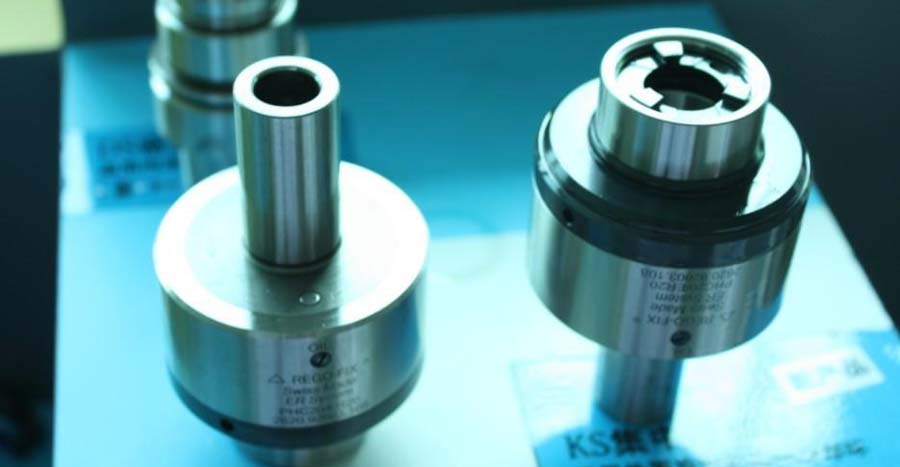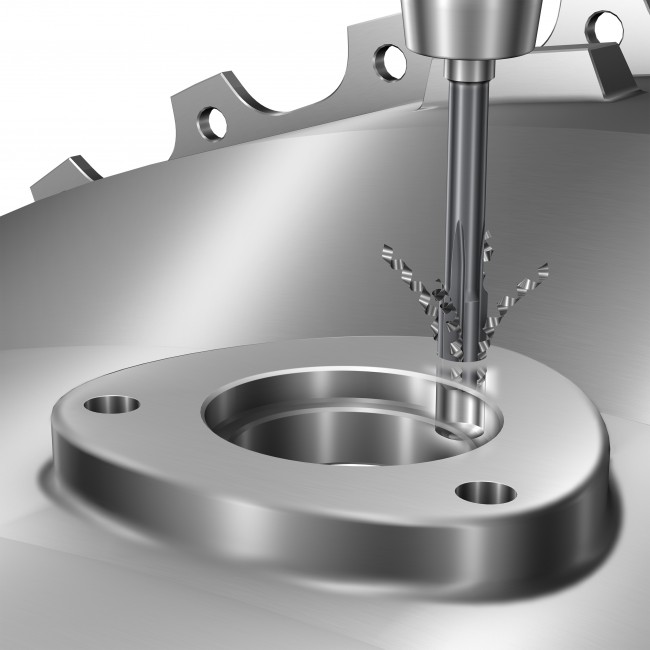In the process of reaming, many problems such as excessive hole diameter and high surface roughness of the inner hole often occur. Today, we summarize the 10 common problems and solutions.
1. The Aperture Increases And The Error Is Large
The design value of the outer diameter of the reamer is too large or the reamer has burrs.
The cutting speed is too high.
Improper feed or excessive machining allowance.
The entering angle of the reamer is too large.
The reamer is bent.
There is a cutting edge on the reamer.
The swing of the reamer edge is too poor during sharpening.
The cutting fluid selection is inappropriate.
When installing the reamer, the oil on the surface of the taper handle was not cleaned or the taper surface was bumped.
The flat tail of the taper shank is offset into the machine tool spindle and the taper shank conical interference.
The spindle is bent or the spindle bearing is too loose or damaged.
The reamer floating is not flexible.
Different axis from the workpiece.
When hand reaming, the force of both hands is uneven, which makes the reamer shake left and right.
Solution
Appropriately reduce the outer diameter of the reamer according to the specific situation.
Reduce cutting speed.
Properly adjust the feed or reduce the machining allowance.
Appropriately reduce the entering angle.
Straighten or scrap the bent unusable reamer.
Carefully trim with oil stone to pass.
Control the swing difference within the allowable range.
Choose a cutting fluid with better cooling performance.
Before installing the reamer, wipe off the oil on the taper shank of the reamer and the taper hole of the machine tool spindle, and polish the taper surface with oil stone.
Sharpen the flat tail of the reamer.
Adjust or replace the spindle bearing.
Readjust the floating chuck and adjust the coaxiality.
Pay attention to correct operation.

2. The Aperture Is Reduced.
The design value of the outer diameter of the reamer is too small.
The cutting speed is too low.
The feed rate is too large.
The entering angle of the reamer is too small.
The cutting fluid selection is inappropriate.
During sharpening, the worn part of the reamer is not worn away, and the elastic recovery reduces the hole diameter.
When reaming steel parts, the margin is too large or the reamer is not sharp, which is easy to produce elastic recovery and reduce the aperture.
The inner hole is not round and the hole diameter is unqualified.
Solution
Change the outer diameter of the reamer.
Increase the cutting speed appropriately.
Appropriately reduce the feed rate.
Increase the entering angle appropriately.
Choose oily cutting fluid with good lubrication performance.
Change the reamer regularly and sharpen the cutting part of the reamer correctly.
When designing the size of the reamer, the above factors should be considered, or the value should be selected according to the actual situation.
Make a trial cut, take a suitable margin, and sharpen the reamer.
3. The Reamed Inner Hole Is Not Round
The reamer is too long and the rigidity is insufficient, causing vibration during reaming.
The entering angle of the reamer is too small.
The reamer has a narrow cutting edge.
The reaming allowance is too low.
There are gaps and cross holes on the surface of the inner hole.
There are blisters and pores on the surface of the hole.
The spindle bearing is loose, there is no guide sleeve, or the clearance between the reamer and the guide sleeve is too large.
Because the thin-walled workpiece is clamped too tightly, the workpiece is deformed after unloading.
Solution
For reamers with insufficient rigidity, reamers with unequal pitch can be used. The installation of the reamer should be rigidly connected to increase the entering angle.
Use qualified reamer to control the hole position tolerance of the pre-processing process.
Adopt unequal pitch reamer, adopt longer and more precise guide sleeve.
Select qualified blanks.
When reaming more precise holes with equal pitch reamer, the clearance of the machine tool spindle should be adjusted, and the matching clearance of the guide sleeve should be required to be higher.
Use proper clamping method to reduce clamping force.
4. The Inner Surface Of The Hole Has Obvious Edge Faces
The reaming allowance is too large.
The clearance angle of the cutting part of the reamer is too large.
The reamer blade is too wide.
There are pores and blisters on the surface of the workpiece.
The spindle swing difference is too large.
Solution
Reduce the reaming allowance.
Reduce the clearance angle of the cutting part.
Sharpen the width of the land.
Select qualified blanks.
Adjust the machine spindle.
5. High Surface Roughness Of The Inner Hole
The cutting speed is too high.
The cutting fluid selection is inappropriate.
The entering angle of the reamer is too large, and the cutting edges of the reamer are not on the same circumference.
The reaming allowance is too large.
The reaming allowance is uneven or too small, and the partial surface is not reamed.
The cutting part of the reamer has excessive swing, the cutting edge is not sharp, and the surface is rough.
The reamer blade is too wide.
Chip removal is not smooth during reaming.
Excessive wear of the reamer.
The reamer is bruised, with burrs or chipping on the cutting edge.
There is a built-up edge on the cutting edge.
Due to material relations, it is not suitable for zero-degree rake angle or negative rake angle reamer.
Solution
Reduce cutting speed.
Choose cutting fluid according to the processing material.
Appropriately reduce the entering angle and sharpen the reamer edge correctly.
Appropriately reduce the reaming allowance.
Improve the position accuracy and quality of the front bottom hole of the reaming or increase the reaming allowance.
Use qualified reamer.
Sharpen the width of the land.
According to the specific situation, reduce the number of teeth of the reamer, increase the space of the chip pocket or use a reamer with an inclination of the blade to make chip removal smooth.
Replace the reamer regularly and grind away the grinding area when sharpening.
During the sharpening, use and transportation of the reamer, protective measures should be taken to avoid bumps.
For the reamer that has been bruised, use extra-fine oilstone to repair the bruised reamer, or replace the reamer. Use oilstone to trim the reamer to pass, and use a reamer with a front angle of 5°-10°.
6. The Service Life Of The Reamer Is Low
The reamer material is inappropriate.
The reamer burned during sharpening.
The cutting fluid selection is inappropriate, and the cutting fluid cannot flow smoothly to the cutting area.
The surface roughness value after sharpening the reamer is too high.
Solution
According to the material to be processed, the reamer material can be selected, hard alloy reamer or coated reamer can be used.
Strictly control the amount of grinding and cutting to avoid burns.
The cutting fluid is often selected correctly according to the processing material.
Frequently remove the chips in the chip flute, and use cutting fluid with sufficient pressure to achieve the requirements after fine grinding or grinding.

7. The Position Accuracy Of The Reamed Hole Is Too Poor
The guide sleeve is worn.
The bottom end of the guide sleeve is too far from the workpiece.
The guide sleeve is short in length and poor in accuracy.
The spindle bearing is loose.
Solution
Regularly replace the guide sleeve.
Lengthen the guide sleeve to improve the matching accuracy of the gap between the guide sleeve and the reamer.
Timely repair the machine tool and adjust the spindle bearing clearance.
8. Reamer Tooth Chipping
The reaming allowance is too large.
The hardness of the workpiece material is too high.
The cutting edge swing is too large and the cutting load is uneven.
The entering angle of the reamer is too small, which increases the cutting width.
When reaming deep holes or blind holes, there are too many chips and they are not removed in time.
The teeth of the knife were worn during sharpening.
Solution
Modify the pre-processed aperture size.
Reduce the material hardness or switch to a negative front angle reamer or a cemented carbide reamer.
The control swing is within the qualified range.
Increase the entering angle.
Pay attention to timely removal of chips or use a bladed angle reamer.
Pay attention to the quality of sharpening.
9. Broken Reamer Handle
The reaming allowance is too large.
When reaming a taper hole, the rough and fine reaming allowance allocation and cutting amount selection are inappropriate.
The reamer tooth has a small chip capacity and the chip is blocked.
Solution
Modify the pre-processed aperture size.
Modify the allowance allocation and choose the cutting amount reasonably.
Reduce the number of teeth of the reamer, increase the chip space or grind one tooth away from the tooth gap.
10. The Center Line Of The Hole After Reaming Is Not Straight
The drilling before reaming is skewed, especially when the hole diameter is small, due to the poor rigidity of the reamer, the original curvature cannot be corrected.
The entering angle of the reamer is too large.
Poor guidance makes the reamer easy to deviate during reaming.
The inverted cone of the cutting part is too large.
The reamer is displaced at the gap in the middle of the intermittent hole.
When hand reaming, too much force in one direction forced the reamer to deflect to one end, destroying the verticality of the reaming.
Solution
Add reaming or boring process to correct holes.
Reduce the entering angle.
Adjust the appropriate reamer.
Replace the reamer with a guiding part or a longer cutting part.
Pay attention to correct operation.


